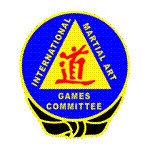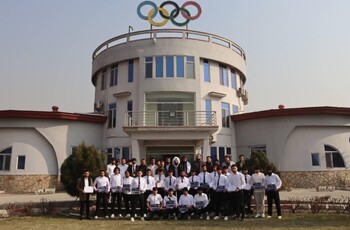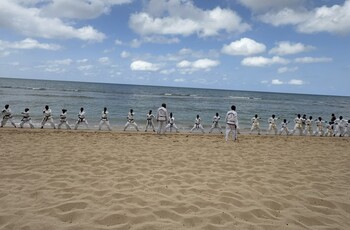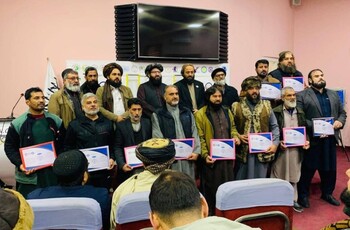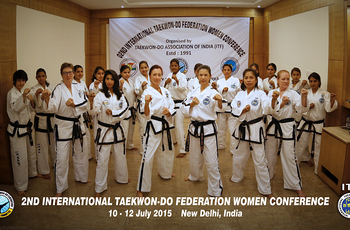International Taekwon‑Do Federation
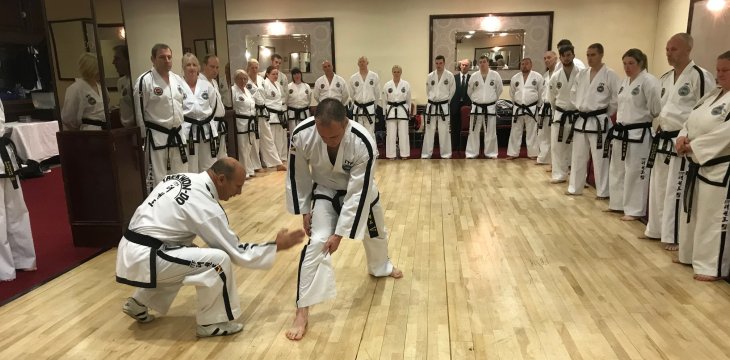
An ITF International Instructor Course, conducted by Grandmaster Francis Barrett, was held in Dublin, Ireland from the 19th to 20th of October. This seminar was attended by practitionersfrom RITA schools from around the country and some guests from the UK, which is always good to see. The grades attending ranged from black tag to 8th degree black belt. On day one Grand Master Barrett catered for all grades whereas the second day was geared towards black belts.
The course began with the performance of fundamental movements, practicingstances, punches and basic blocks. The focus in the beginning was the stances, examining the proper way to execute these foundational building blocks and the importance of these stances. The technical side was emphasised on both days, with the very correct philosophy that to teach students, the instructors must understand how and why movements are performed the way in which they are. We then graduated to punching and blocks. For example, students were shown the difference between knifehand low block and outer forearm low block and the correct target area for each block and the target of high punches on an attacker’s body. After performing these up and down the floor, we partnered up and practiced these in a three-step sparring scenario. Emphasis was put on ensuring that the techniques worked for their intended purpose, and once that was established, we performed exercises to improve accuracy and reaction times. We subsequently performed four directional punch and four directional block.
Grand Master Barrett explained the importance of practicing these techniques on each other correctly as opposed to just repeating a technique incorrectly, this will then filter down to the studentsthroughout our schools also. It is important that there is consistency in executing and then teaching the correct movements from General Choi, Grand Masters and Masters to the students.
The rest of the day continued with the focus being placed on patterns. These were performed from Chon -Ji up to Chung-Moo. Each pattern was executed in our own time, and then we thoroughly discussed the reason for each movement. After every pattern, an opportunity was given for participants to ask questions on the patterns and individual movements of which GM Barrett answered in detail. This was with the express reason to be prepared and knowledgeable for any unusual questions which could arise from the more inquisitive of students, as well as to improve the understanding and execution of the patterns by the instructors themselves.
More complicated techniques were practiced with a partner, to ensure that they were effective in their application. These exercises also gave a far better technical understanding of the patterns. Once these steps were completed, we redid the pattern on the count. Throughout the day, techniques and patterns were taught with emphasis given to how the training secrets of Taekwon‑Do, including applying the theory of power, should be considered for each of the movements and the importance of using breath control, sine wave and hip twist movements to maximise the force generated.
At the end of the day, we carried out some self-defence exercises. We went through many of the releases and grabs on the grading syllabus, as well as some of the knife attacks. Students weretaught about vital points on the body, including that there are 69 vital pressure points, which should be the target of attack when a person’s bodily integrity or life may be in danger.Everything was discussed with an emphasis on using what worked. Throughout the day, questions were not only allowed but thoroughly encouraged. Each question was answered satisfactorily, and an in-depth analysis of the topic or technique was performed.
The second day began with the first-degree black belt patterns, Kwang-Gae, Po-Eun and Ge-Back with the same detailed discussion on how and why we execute the techniques.
Under the watchful eye of Grand Master Barrett, special guest Grand Master Mitchell, Master Doyle and Master Jacob, students attempting to fulfil their C-level national instructor qualifications went on the floor and instructed a volunteering black belt to perform a pattern both on the count and in their own time with some corrections and comments.
The C instructor task was to observe initially and help the student on one of the patterns from Saju Jirugi up to Do-San. Emphasis was placed on observing the patterns from different angles therefor the instructor was encouraged to move and observe from alternate angles while ensuring that the distance was enough not to put any unnecessary pressure on the performing student. The importance of proper etiquette (such as introductions), confidence and a relaxed demeanour were highlighted, as they make the student feel more relaxed and confident in turn, while creating the proper instructor-student dynamic.
With such a wide range from 1st to 8th degree attending, in the interest of time the participants were split into groups based on grade ensure the patterns were covered off and also that the C-,B- and A-level instructor courses were covered with due detail and diligence.
The group of students attempting to receive their C-level instructor course were taken by Master Jacobs (as the great majority of these were first degrees) to go through some pertinent information and training regarding the teaching of beginners. Students above first-degree remained with Grandmaster Barrett and continued doing their patterns. With Master Jacobs, we discussed how to start of the teaching of fundamental movements to complete beginners. We began by discussing how to teach students to make a fist, and then moved on to the correct positions of measures for middle, high and kicking techniques when doing 3-step sparring. We went through 1-4 of the 3-step sparring syllabus, as Master Jacobs highlighted how to make this understandable and accessible to starting students.
Subsequently, Master Doyle and Master O’Doherty took the entire group of aspiring C-level instructors, while Master Jacobs took those trying to get their B- and A-level instructor qualifications. The of Taekwon‑do, from fundamental movements to self-defence was explained, and we started off with learning how to teach fundamental movements. As the majority of beginner students are children, we were taught how to make the classes accessible and at what pace to teach. Teaching methods for classes in confined spaces was also discussed. We worked our way up to teaching four-directional punch, with volunteers from the group ‘teaching’ the other students. The necessity for clear and concise instructions was illuminated. After we progressed to doing four-directional punch, we then moved on to kicks. We were taught exercises for building up the necessary flexibility and strength to perform kicks. It was elucidated that static stretches should be left for the end, as they can induce muscle cramps or pulling if performed before strenuous activity such as kicks. Throughout all, paying close attention to the needs and abilities of the class was promoted. Light competitiveness, particularly among youths, was highlighted as a useful trait to take advantage of while teaching students. For example, a reward, given to the very young, for performing a full side splits was mentioned as a technique to promote flexibility in classes made up of predominantly children.
Students attending IIC in order to complete the B and A course continued with Grand Master Barrett to go through the more advanced patterns and detail that is required to be a competent instructor and delivering the message from General Choi with consistency.
We then all went through step-sparring. 3-step to 1-step were covered. We partnered up so that we could practice the step-sparring ourselves. Discussion about the correct measuring up for techniques was covered with regards to 3-step. It was elucidated that for both 2-step and 1-step the measuring up was meant to be performed by sight, as students should be used to their own distance by that point. The importance for both parties being ready was highlighted, and the shouting of ‘kihap’ was performed before any movements by both participants.
Finally, all students were asked to observe Tong-Il being performed by the present masters, as it is the final of the 24 patterns and an opportunity for students to observe a pattern of an advanced grade being performed.
Over the two days of the ITF International Instructor seminar, the students received intensive training that included information on developing their own techniques, the application of these techniques and methods of effective teaching methods. Students were also taught about the history of Taekwon‑Do, which can also be found in the interpretation of patterns, as well as embedded within the patterns. Throughout the two days of training, the explanation and importance of the tenets of Taekwon‑Do were highlighted, with examples given during exercises. All 24 of the patterns were performed, the basis of the techniques was explained and practical partner drills and demonstrations reinforced the students understanding of the correct application of each specific technique and the opportunity to practice the proper execution of these movements. The importance of consistency in teaching the message of Taekwon‑do as General Choi intended was highlighted and reinforced with every step.
Taekwon.





